I shared a photo of my grandmother Eveline Coates’ high school graduating class in Mystic, Iowa a few weeks ago. Along with the photo and her diploma, a couple of other mementos were saved. One is the program for the Junior-Senior Banquet in honor of the graduating Seniors. It was interesting to see how World War I seemed to be the overarching theme of the festivities. I decided to take a deeper look at what her life may have been like during the 1917-1918 school year. There was a lot going on, a war and the beginning of an influenza pandemic to name the two biggies. See:
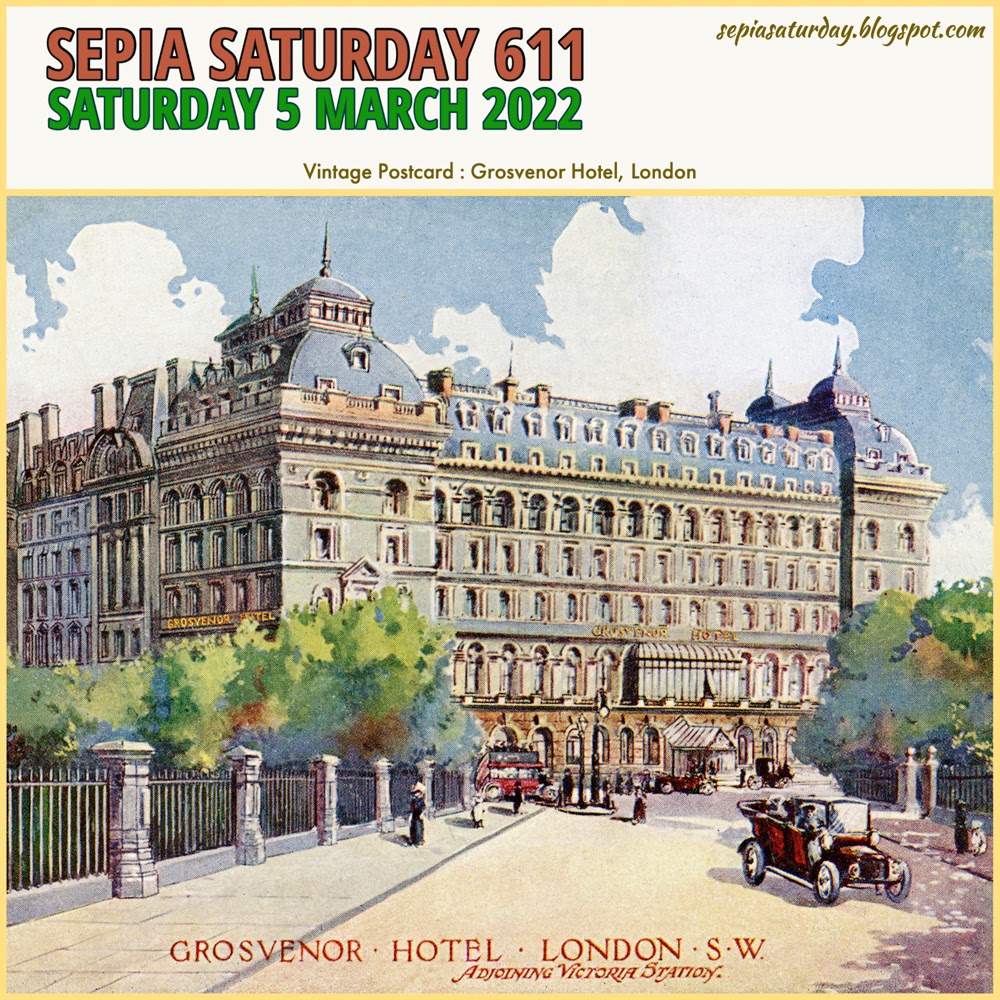
The prompt photo for Sepia Saturday nudged me to focus on the town of Mystic, Iowa – the places where Eveline spent time, the places that represented her world and her town. Alas, there were no hotels or buildings quite as grand as the one in the prompt photo. The population of Mystic in 1917-1918 was somewhere around 2,700. The population increased from 1,758 in 1900 to 2,663 in 1910. By 1920, the population had grown to 2,796. These were the boom years when coal production peaked in the city and county.
The building where Evelline spent most of her time away from home during her senior year was the new Mystic High School, which opened its doors in 1915. Eveline shared some thoughts about the new school in an autobiography she wrote when she was sixteen, perhaps in the fall of 1917:
Then came the fight for the new school house and a half term of school in the U. B. Church. This didn’t benefit any of us as we did as much talking and so forth, as ever. But in the new building a perfect rule of tyranny began. For no talking is allowed after you enter the building until you leave again. Of course we obey this rule in every respect, even keeping still during recitation.

Do I detect a note of sarcasm?
The photo below appears in History of Mystic, Iowa: 1887-1987. All those children sitting outside the United Brethren Church lead me to believe that this was taken during the time it was used as a temporary school. Surely all those children did not attend the church!
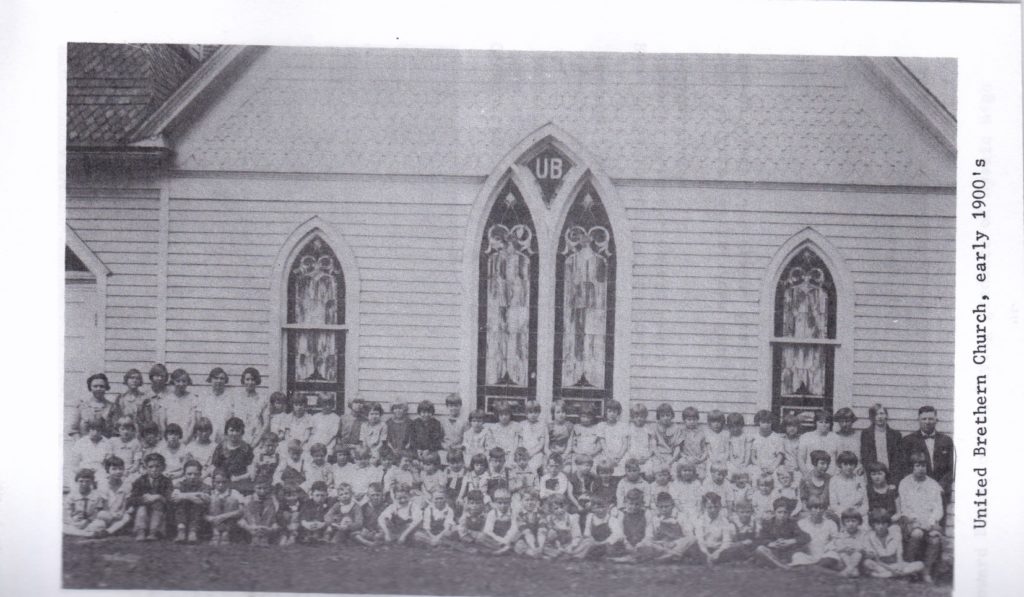
I don’t know if Eveline is in this photo. I think the older girl 4th from the left in the back row most resembles my grandmother. Or maybe the 6th girl from the left??? (Click to enlarge.)
I’m not sure what church Eveline attended, or how often she was present. She was baptized at the Church of Christ in 1916, where the funeral of her grandmother Celia Jenkins Harris was held. Other family funerals seem to have been at the Methodist Episcopal Church, and that is also where Eveline married in 1923. The photo below includes the Methodist church and the “old” high school, which was torn down and rebuilt.
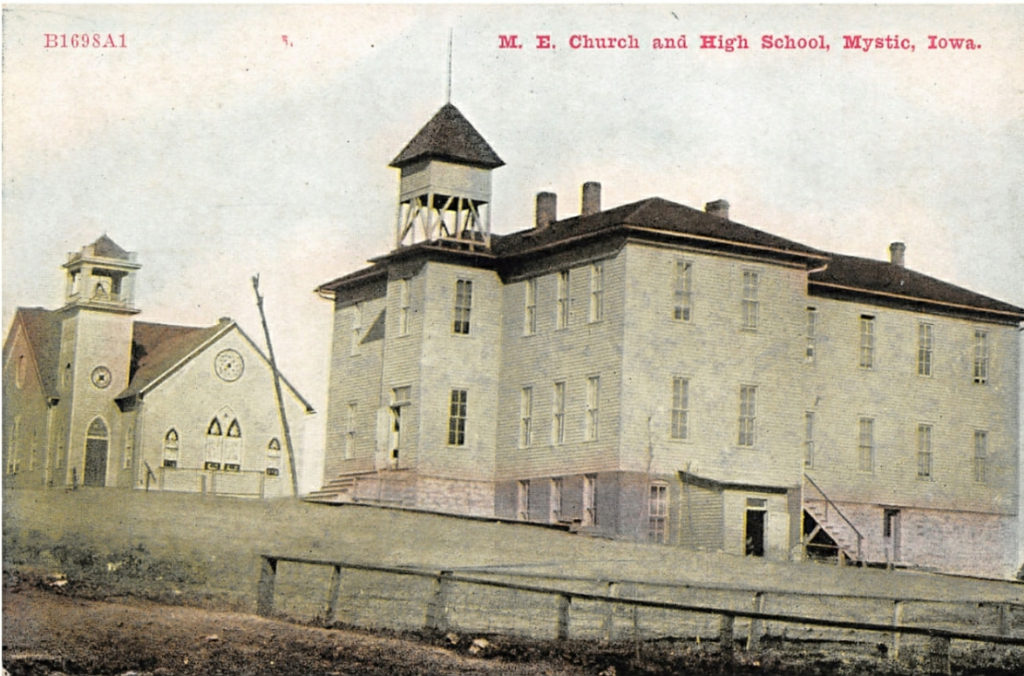
The History of Mystic, Iowa: 1887-1987 states that there were five churches in town: Methodist, Christian, United Brethren, Catholic, and Second Baptist. No Church of Christ is listed to confirm Eveline’s baptism.
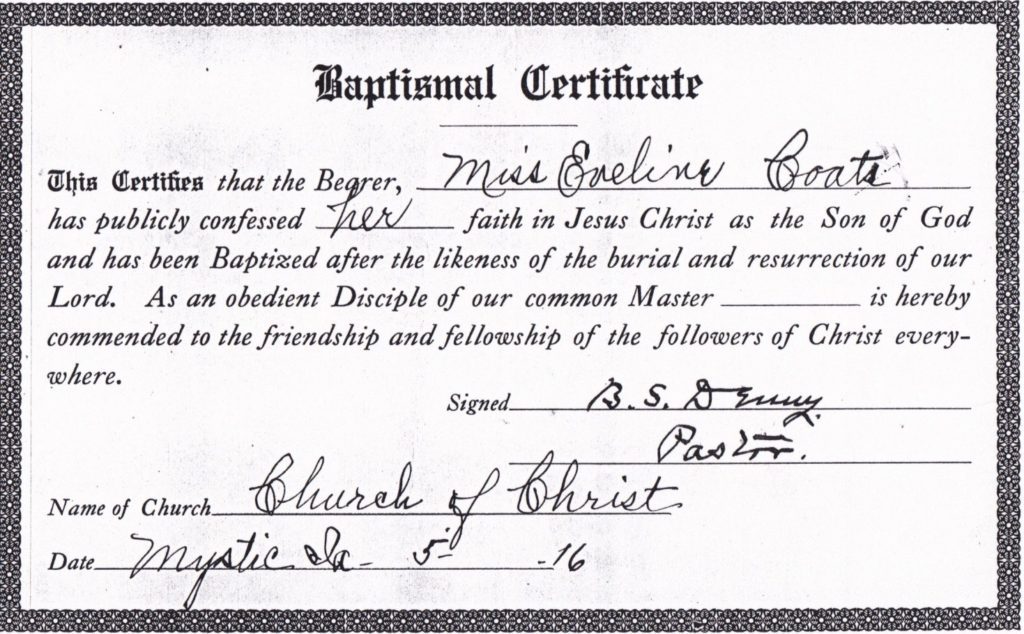
But Wikipedia has an explanation for that: “The churches are independent congregations and typically go by the name “Christian Church”, but often use the name “Church of Christ” as well.” I’ll assume that the Church of Christ in town was commonly referred to as the Christian Church.
The streets of Mystic were unpaved, subject to ruts, rain, and dust if not oiled. Main Street was paved with bricks sometime in 1918. Some residents had cars and were reported in the newspaper to have “motored” to one town or another to visit family or attend an event. Many likely still relied on horse powered transport as well as their own two feet. I found a few pictures from the 1920s-30s of people on horses in town and another of the mail being delivered in another part of the county by horse and buggy. There is an undated photo of Eveline’s parents, Joseph and Mary Coates, standing by a buggy. In 1917, they would have been 50 and 45, respectively. It is hard for me to tell their ages in this photo.
If you wanted to travel to Centerville, the county seat, you could hop on the Interurban.
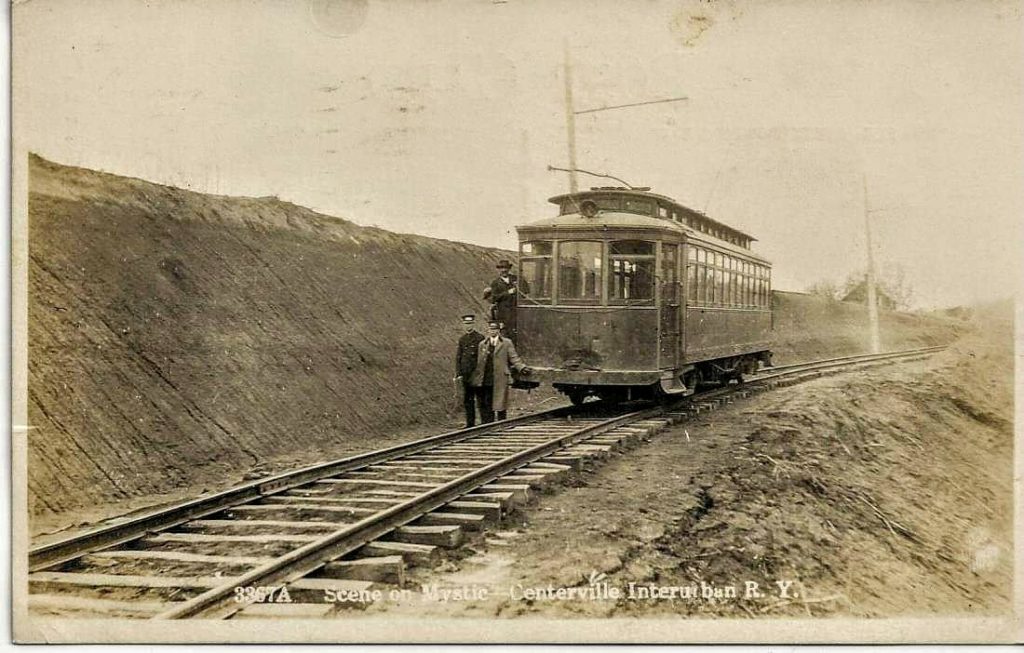
Following are a few memories shared by a Mystic resident, with some photos interspersed:
In 1910 our Sunday afternoon entertainment was watching trains come and go from the Mystic Depot.

Later on, streets were oiled to Walnut City, making an initial improvement. In 1918, Main Street was bricked which remains to this day. The town burned twice. The first fire was in 1910 and burned the east end of town from Second Street to the west. In 1911, it burned from Second Street towards the east. Bradley’s Bank did not burn until the fire in 1912. The livery barn on Second Street stopped the fire because the posts were cut which toppled the metal roof thus smothering it.
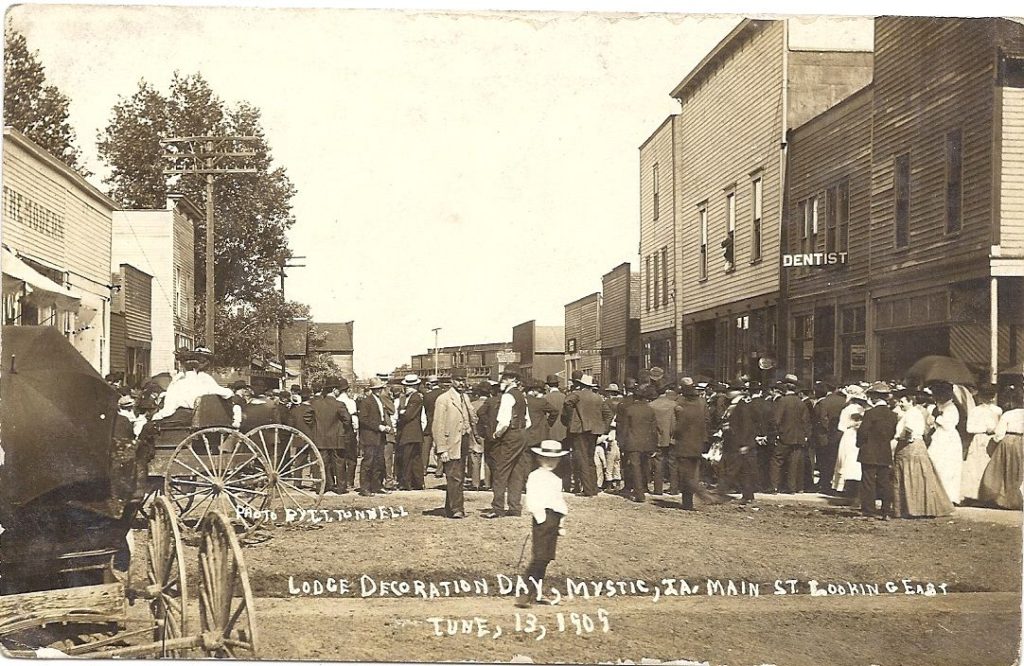
Mystic had two opera houses. The first one was on the north side of the street over Scott and Minor’s Grocery Store. It burned down when Mystic burned the first time. The second Opera House was located where Strand Theatre stood. Karl Breeding operated the first “picture show.” Mystic also had a town band under the leadership of Lem Hicks. A community symphony orchestra was also formed, consisting mostly of French and Belgian musicians. At one time, Mystic had three hotels and many boarding houses. Every year Mystic had a Fourth of July celebration which included a Sham Battle, shooting blanks out of guns.
History of Mystic, Iowa: 1887-1997. pg. 37-39.
The burned out portions of Main Street were rebuilt mostly in brick. I visited Mystic with my aunt and uncle in September 2016. We were trying to cover a lot of area that day, including cemeteries, and you can see from the clouds that bad weather was approaching, so our time was limited. I only took the one photo of Main Street from the car. I wish I had taken more and that I had done a little research before I made the trip so I would have had a better idea of what to look for. Oh well. It appears that I was at the opposite end of the street from the old photo above.

Not a full picture of the town that Eveline knew and loved, but a glimpse. I’ll keep working on it!
This is my contribution to Sepia Saturday. Click the link to see and read how others have responded to the prompt.

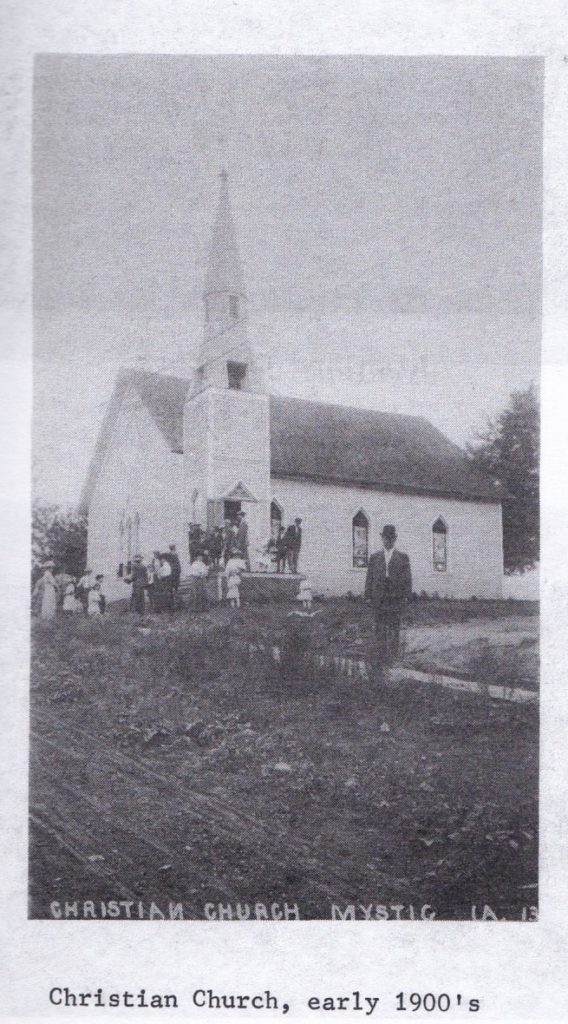
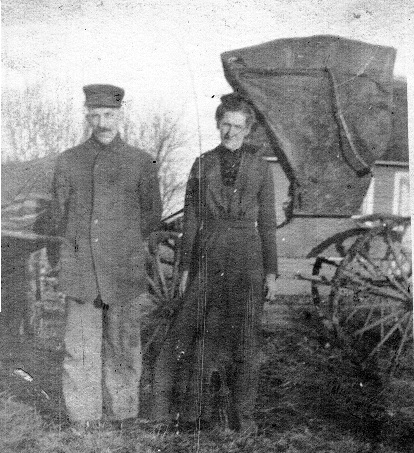
This was a great tour of your grandmother’s hometown, Kathy. Most of American history is really about the stories of thousands of small communities like Mystic, rather than the big metropolitan centers. Many years ago, way before I became a collector of old photos, I read a book that changed my approach to travel. The title is “Blue Highways: A Journey into America” by William Least Heat-Moon. The author set off on a cross country adventure in his truck driving only on the old US routes and backroads which used to be marked blue on most maps. I’ve tried to do the same whenever I take a long drive, and have been rewarded by discovering many beautiful small towns like Mystic. Even if forced to drive on an interstate I take a break for meals by driving beyond the fast food junctions into a small town to look for a local diner. Real food and good conversation with authentic town folk always makes for better travel stories.
A fascinating and detailed profile of Mystic in the early 20th century.